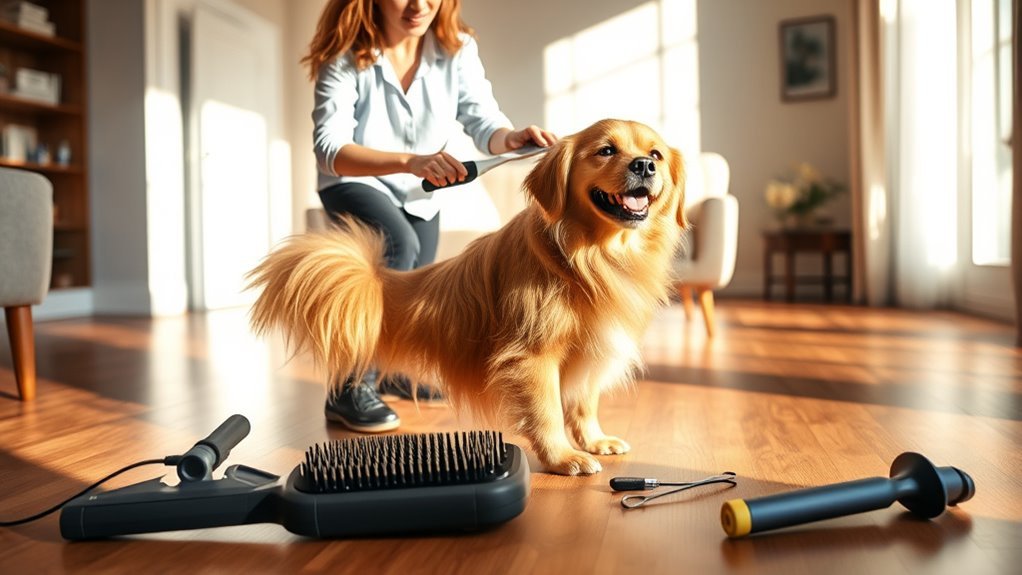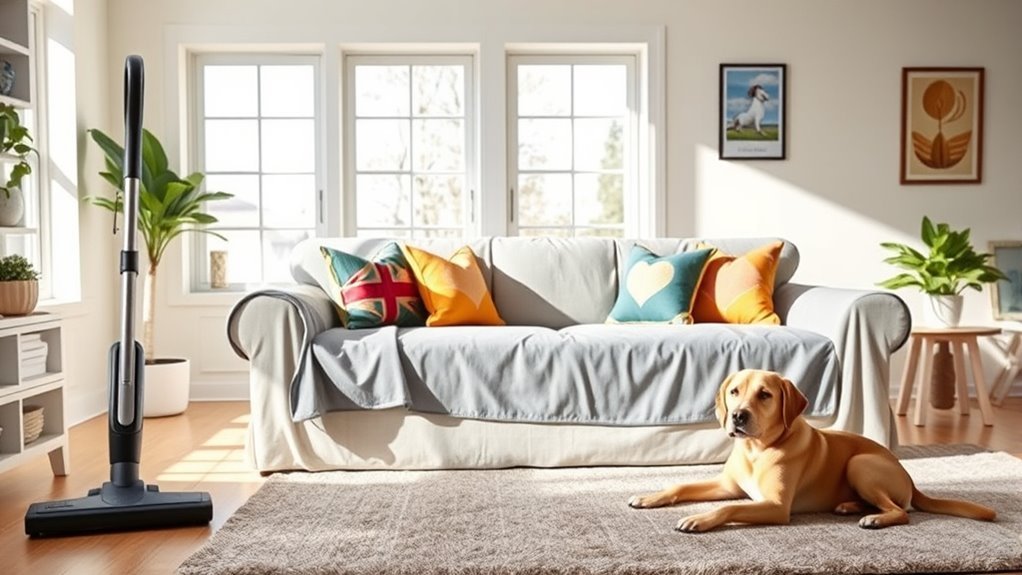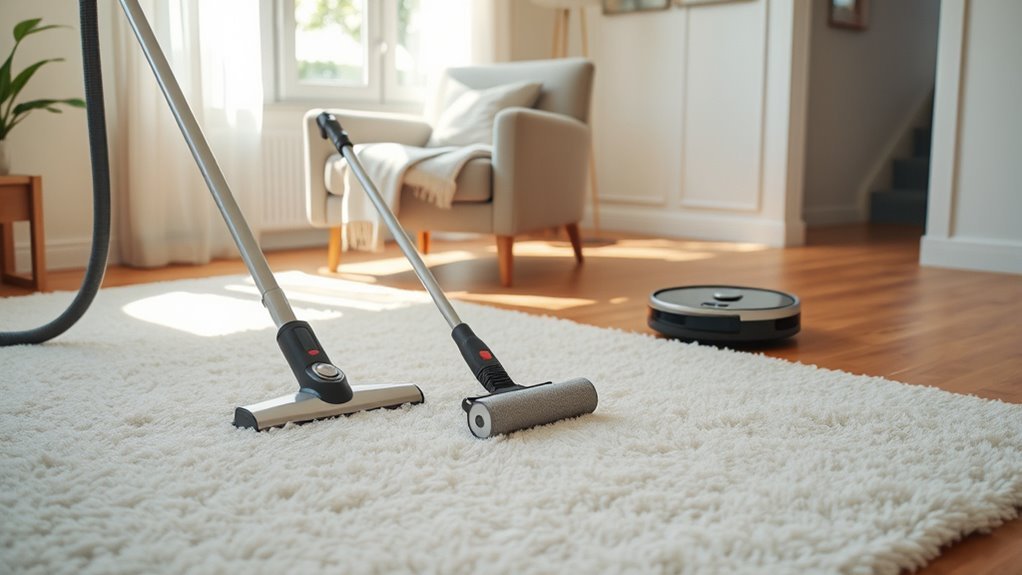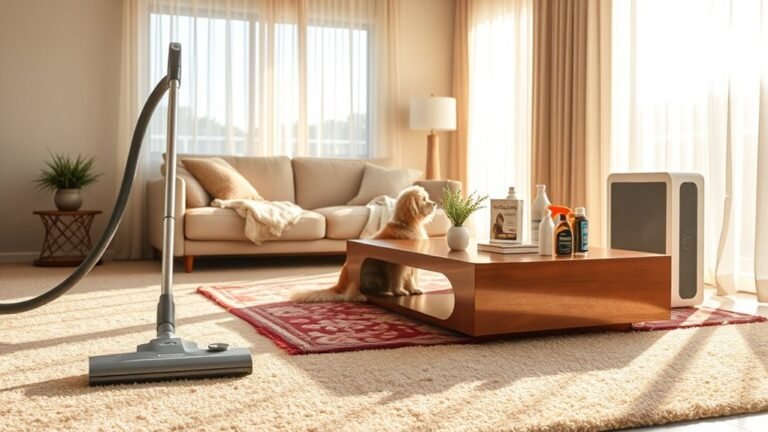How Pet Owners Can Maintain a Fur-Free Home
You can keep your home fur-free by grooming your pet regularly to reduce shedding and using the right vacuum with strong suction and pet hair attachments. Protect your furniture with washable covers and choose pet-friendly fabrics that resist hair. Air purifiers with HEPA filters help cut down hair and dander, while a balanced pet diet supports a healthy coat. Creating designated areas also limits fur spread. Explore these tips to simplify fur control and enhance home comfort.
Regular Grooming and Brushing Techniques

Grooming is key to keeping pet hair under control in your home. You’ll want to invest in the right grooming tools to make this task simple and effective. Brushes designed for your pet’s coat type can greatly reduce shedding by removing loose fur before it lands on your furniture or clothes. Establishing a consistent brushing frequency is equally important—daily sessions work best for heavy shedders, while a few times a week might suit others. Regular grooming not only curbs hair buildup but also keeps your pet comfortable and healthy. By taking control of brushing routines, you free yourself from constant cleaning and enjoy a livable space without sacrificing your pet’s happiness or your freedom.
Choosing the Right Vacuum Cleaner for Pet Hair
Although regular brushing reduces shedding, you’ll still need a vacuum cleaner designed specifically for pet hair to keep your home truly fur-free. Choosing the right one gives you the freedom to clean efficiently without hassle. Focus on features that match your lifestyle and home needs.
Regular brushing helps, but a pet hair-specific vacuum ensures a truly fur-free home with effortless cleaning.
Look for:
- Cordless convenience for easy maneuvering around furniture and quick cleanups
- Strong suction power to lift embedded pet hair from carpets and upholstery
- Specialized pet hair attachments like motorized brushes or crevice tools
- HEPA filters to trap allergens and keep air fresh
- Lightweight design for effortless carrying between rooms or floors
With these features, you’ll maintain a fur-free home while enjoying the freedom to move and clean on your terms.
Using Furniture Covers and Pet-Friendly Fabrics

Vacuuming pet hair regularly is a great start, but protecting your furniture helps keep fur buildup to a minimum. You can easily add furniture protection with washable covers designed to repel pet hair and withstand claws. These covers make cleanup effortless and let you enjoy your space without constant worry about fur.
When it comes to fabric selection, choose materials that resist hair adhesion. Tight weaves like microfiber or leather are your best bet—they don’t trap fur and are easy to wipe clean. Avoid loosely woven or textured fabrics, which tend to hold onto pet hair and make cleaning harder. By combining smart furniture protection and thoughtful fabric selection, you’ll maintain a fur-free home that feels open and inviting, giving you more freedom to relax without the mess.
Implementing Air Purifiers to Reduce Hair and Dander
Since pet hair and dander often circulate in the air, using an air purifier can make a noticeable difference in keeping your home cleaner. You’ll improve air quality while enjoying a fresher environment free from floating allergens. To maximize dander reduction, consider these tips when choosing and using an air purifier:
- Select a purifier with a HEPA filter designed to trap pet hair and dander efficiently.
- Place it in high-traffic pet areas to capture airborne particles at the source.
- Run the purifier continuously or during peak shedding seasons for consistent air cleaning.
- Clean or replace filters regularly to maintain peak performance.
- Combine with proper ventilation to support overall air circulation and freshness.
Effective Cleaning Routines for Floors and Upholstery

Keeping your floors and upholstery free from pet hair requires a consistent cleaning routine tailored to the surfaces in your home. Start by vacuuming regularly to catch loose fur before it settles. For upholstery, use microfiber cloths to quickly lift hair and dander without damaging fabric. These cloths attract and hold onto pet hair better than traditional dusters. For deeper cleaning, incorporate steam cleaning into your routine—it loosens embedded hair and eliminates allergens without harsh chemicals. Don’t forget to focus on high-traffic areas where your pet spends most time. By combining these targeted techniques, you’ll enjoy a cleaner, fresher space and more freedom from the hassle of pet hair buildup. Stick to this routine, and maintaining a fur-free home will feel effortless.
Managing Pet Diet and Health to Reduce Shedding
To keep shedding under control, you’ll want to focus on your pet’s diet and overall health. Providing balanced nutrition supports a healthy coat, while regular vet checkups can catch any underlying issues early. Taking these steps can make a big difference in reducing fur around your home.
Balanced Nutrition Benefits
When you provide your pet with a balanced diet rich in essential nutrients, you’re directly supporting healthier skin and coat, which can greatly reduce shedding. By focusing on quality food and incorporating nutritional supplements, you empower your pet’s natural defenses against excessive fur loss. You can also use healthy treats to boost their diet without guilt. Here’s how balanced nutrition helps:
- Supplies omega-3 and omega-6 fatty acids for skin hydration
- Delivers vitamins A and E to support coat strength
- Maintains proper protein levels for fur regeneration
- Includes antioxidants to fight inflammation and irritation
- Supports overall immune health, reducing skin issues
Feeding with freedom in mind means choosing what truly benefits your pet, cutting down shedding, and enjoying a cleaner, fur-free home.
Regular Vet Checkups
Balanced nutrition lays the groundwork for a healthy coat, but regular vet checkups make sure your pet’s diet and overall health stay on track to minimize shedding. When you keep up with vaccination schedules, you protect your furry friend from illnesses that can impact their skin and fur quality. Plus, vets can help with parasite prevention, which is essential since parasites like fleas and ticks cause itching that leads to excessive shedding. During visits, your vet can assess any underlying health issues affecting your pet’s coat and recommend dietary adjustments or supplements if needed. By staying proactive with vet care, you’re not only reducing fur around your home but also giving your pet the freedom to stay happy and healthy without the hassle of constant shedding.
Creating Designated Pet Areas to Contain Fur Spread
To keep pet fur from spreading all over your home, start by choosing furniture that’s easy to clean and pet-friendly. You can also use barriers and mats to create specific areas where your pet can relax without shedding everywhere. These simple steps help contain fur and make cleaning much easier.
Choosing Pet-Friendly Furniture
How can you keep your home stylish without sacrificing cleanliness when pets are part of the family? Choosing pet-friendly furniture is key. Focus on fabric types that resist fur and stains, like leather or tightly woven microfiber. Color selection also matters—opt for shades that camouflage shedding to reduce visible fur. To create designated pet areas that contain fur spread, consider:
- Durable, easy-to-clean fabrics
- Furniture with removable, washable covers
- Elevated or non-fabric pieces to minimize fur buildup
- Color palettes matching your pet’s fur for less noticeable shedding
- Pet-specific cushions or beds that encourage pets to stay in one spot
Using Barriers and Mats
Once you’ve picked pet-friendly furniture, setting up physical boundaries can help keep fur contained. You can explore various barrier options like baby gates or pet playpens to create designated areas where your furry friend can relax without spreading fur everywhere. These barriers give your pet freedom within limits, preserving your clean space.
Choosing the right mat materials is equally important. Opt for mats made of durable, easy-to-clean fabrics like rubber or woven polypropylene. Place these mats near entryways, feeding spots, or favorite pet hangouts to catch shedding fur before it spreads. Mats with textured surfaces also help trap loose hair, making cleanup simpler. By combining smart barrier options with effective mat materials, you maintain a fur-free home without restricting your pet’s comfort or your lifestyle’s freedom.
Frequently Asked Questions
Can Certain Pet Breeds Shed Less Than Others?
Yes, you’ll find that low shedding breeds are a great choice if you want less fur around. Breeds like poodles or basenjis naturally shed less, making your life easier. Plus, combining these breeds with regular grooming techniques like brushing and bathing helps keep shedding minimal. This way, you can enjoy your pet’s company without constantly battling fur, giving you more freedom to relax and live comfortably.
How Often Should Pet Bedding Be Washed?
You want freshness, you want comfort, and you want cleanliness—all in your pet’s bedding. For ideal bedding cleaning, aim to wash pet bedding at least once a week. This washing frequency helps keep fur, dander, and odors under control, giving you and your furry friend a clean, inviting space. If your pet sheds heavily or spends lots of time outdoors, consider washing more often. Regular care means freedom from allergens and mess.
Are There Specific Shampoos That Reduce Shedding?
Yes, you’ll find that anti shedding shampoos can really help cut down on loose fur. Look for products with natural grooming ingredients like oatmeal or aloe vera—they’re gentle and effective without harsh chemicals. Using these natural grooming products regularly can keep your pet’s coat healthy and reduce shedding, giving you more freedom from constant cleaning. Just make sure to follow the instructions for best results and enjoy a cleaner, fur-free space!
Can Stress Cause Increased Pet Shedding?
Yes, stress can definitely cause increased pet shedding. When your pet feels anxious or overwhelmed, their body reacts by shedding more fur as a natural response. Managing stress is key to keeping shedding triggers under control. By creating a calm environment and using stress management techniques like regular playtime and soothing routines, you’ll help your furry friend feel freer and more relaxed, which in turn reduces excessive shedding.
What Indoor Plants Help Improve Air Quality With Pets?
If you’re looking to freshen up your space, air purifying plants are a great choice. You’ll want to pick pet safe options like spider plants, Boston ferns, or bamboo palms. These not only improve indoor air quality but also keep your furry friends safe. So, you can enjoy cleaner air without worrying about harmful toxins—letting you and your pets roam freely and comfortably in your home.






